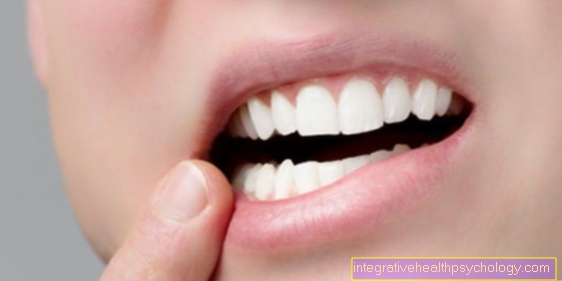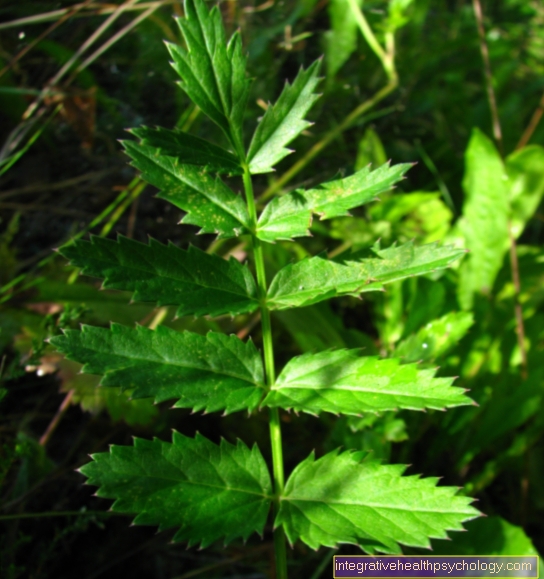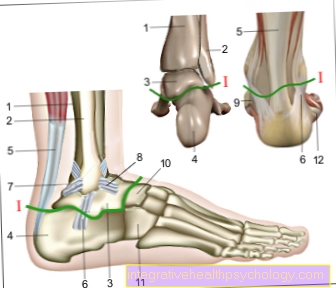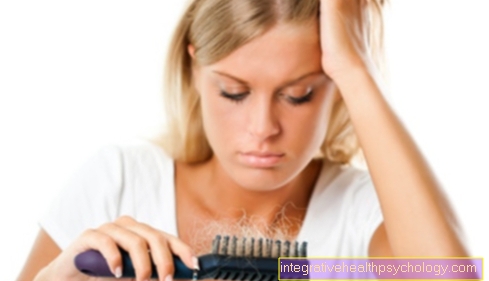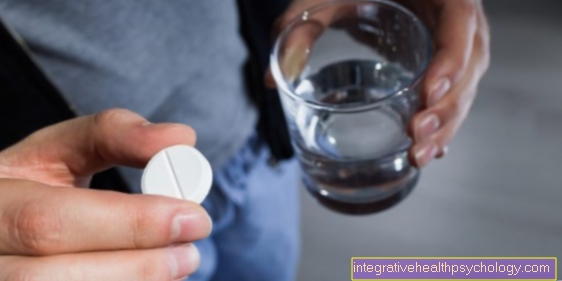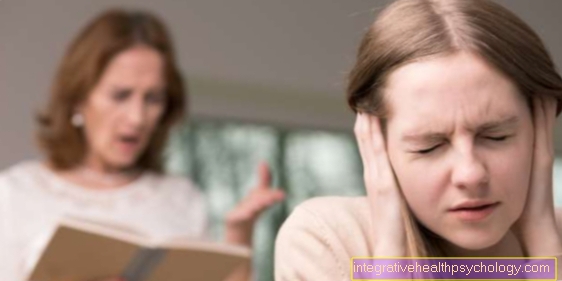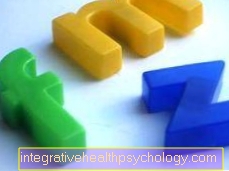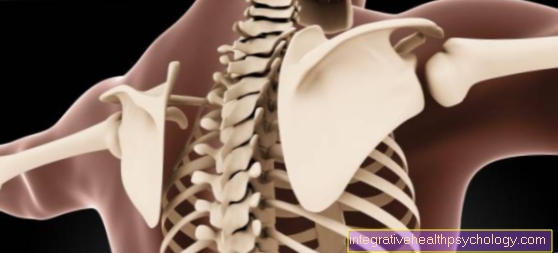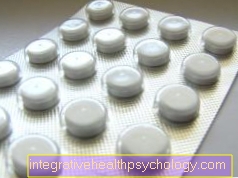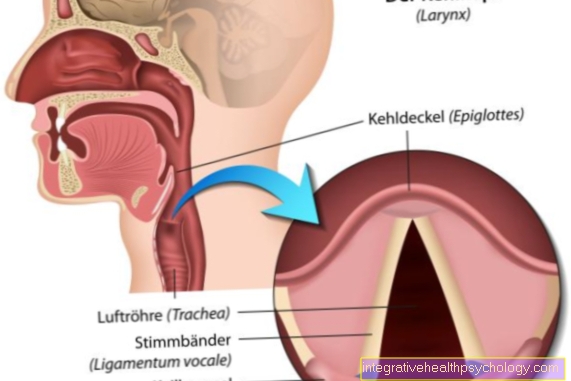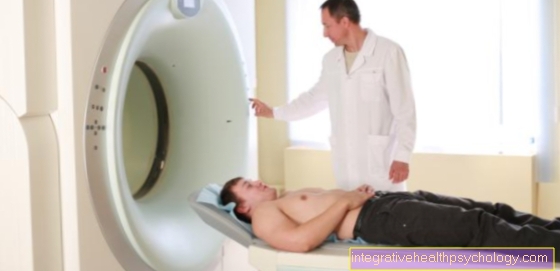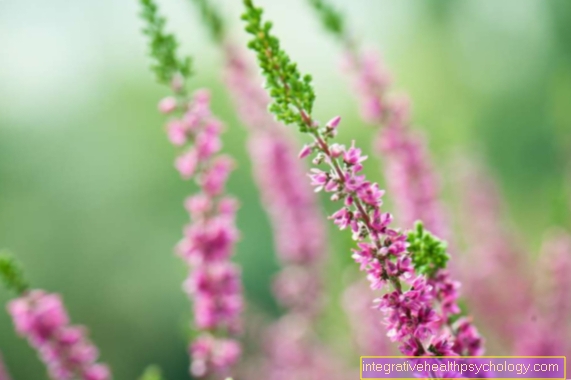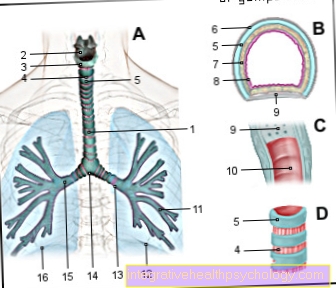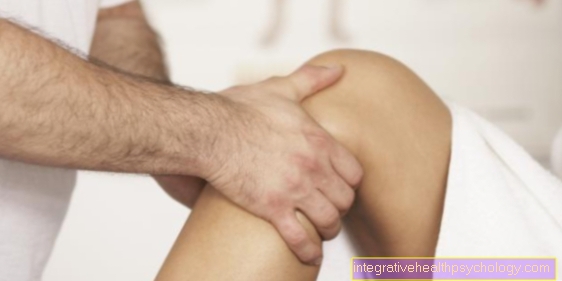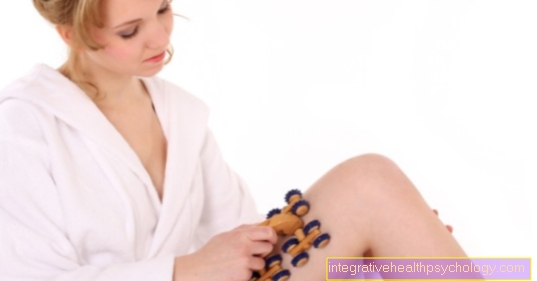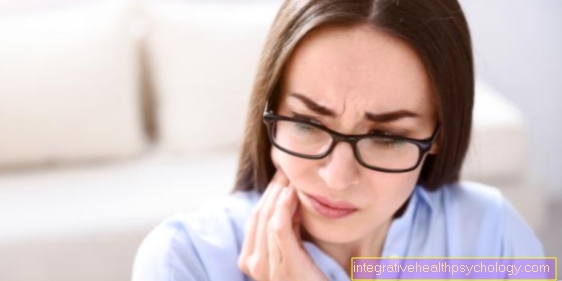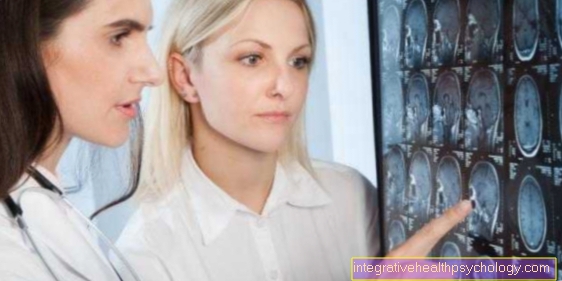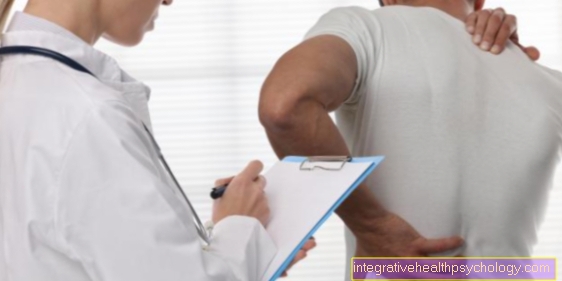The ligaments of the spine
introduction
The entirety of the ligaments in the spine is called the ligamentous apparatus. Due to the high number of vertebrae, there are numerous ligaments in the spine. The ligamentous apparatus has to fulfill numerous tasks, especially on the spine, since the body's range of motion should not be reduced under any circumstances. One of these movements is the rotation, one lateral inclination in both directions and the Forward tilt and back.
At the same time, the ligaments of the spine should also give stability, enable upright standing and protect against unnatural movements.
In addition, one has to distinguish between the ligaments of the cervical spine, the tailbone and the rest of the spine in the spine. Because in the head and neck area further demands are made on the ligamentous apparatus and in the area of the coccyx there is a very strong ligamentous apparatus that suppresses almost any movement.

An overview of the ligaments of the spine
A well-known portion of the spinal ligaments is the Intervertebral disc, the so-called intervertebral disc. This is located between all vertebral bodies and serves as a shock absorber between the individual vertebral bodies. The rest of the ligamentous apparatus is divided into vertebral body ligaments and vertebral arch ligaments. The classification is based on the anatomical structure of the individual vertebrae.
The vertebral arches connect to the back of the vertebral bodies and together with them form a cavity that contains the spinal cord. On the vertebral arches there are two transverse processes and a spinous process that protrudes backwards. In total there are two vertebral ligaments: that Longitudinal anterior ligament (in front of the vertebral body) and that Posterior longitudinal ligament (at the back of the vertebral body). Roughly speaking, these run from the base of the skull to the coccyx and strengthen the spine in front and behind. The vertebral arch ligaments include the Ligamenta flava, the Ligamenta interspinalia, the Supraspinal ligament, the Ligamentum nuchae and the Ligamenta intertransversaria.
- Ligamenta flava: consist of elastic fibers and run between all vertebral arches; they represent the wall of the spinal canal
- Ligamenta interspinalia: run between all spinous processes of the vertebral arches and connect them to one another
- Ligamentum supraspinale: runs as a single ligament from the coccyx to the seventh cervical vertebra and merges from there into the ligamentum nuchae
- Ligamentum nuchae: represents a flowing, widened transition and ends at the occiput
- Ligamenta intertransversaria: run individually between the transverse processes of the vertebrae and stabilize the spine in a lateral direction as well as in rotation
The ligamentous apparatus of the cervical spine also includes the posterior atlantooccipital membrane, the tectoria membrane, the crucifome atlantis ligament, the alaria ligament, the lateral atlantooccipital ligament and the dentis apic ligament. However, these ligaments are all very complex.
More information can be found here: Spine anatomy
Overstretched ligaments of the spine
Overstretching of the spinal ligaments is caused by excessive movements, for example as a result of an accident or as a result of unnatural movements. In any case, a great deal of force is necessary for this, as the straps are usually very stable and cannot be easily extended.
The most common causes of overstretching are jerking movements in a traffic accident or fall, or incorrectly performing sports exercises. The symptoms that go with it range from a general one Feeling of instability, increased mobility and persistent back pain.
In order to prevent serious long-term effects such as involvement of the spinal cord, one should seek medical treatment. If this is not possible, you should at least take it easy for a while. This can be several days or a few weeks. This allows the ligamentous apparatus to regenerate and improves stability.
You might also be interested in: Vertebral blockage
Inflammation of the ligaments of the spine
The ligaments of the spine can also be affected by inflammation. However, such inflammation is comparatively rare. In contrast to overstretching the ligaments, however, an inflammation leads to a stiffening of the spine as a long-term consequence. There are generally two possible reasons for this.
- On the one hand, so-called Bechterew's disease can be the trigger. This is an autoimmune disease that belongs to the rheumatic group. This disease mainly affects the lower parts of the spine and the joint between the pelvis and the spine, the sacrum-iliac joint. As the disease progresses, the spine flexes. Inflammatory processes in the vertebral joints and the surrounding ligaments of the spine lead to a complete stiffening of the entire spine. In the early stages, the disease usually manifests itself as back pain at night and occurs in phases and can lead to breathing problems in later stages. The doctor treats ankylosing spondylitis with anti-inflammatory drugs.
- On the other hand, it can be caused by inflammation of the vertebral bodies, which first spreads to the intervertebral discs and later to the ligamentous apparatus. This inflammation of the vertebrae and disc is called spondylodiscitis. This disease usually has a local origin.
Read about it too: Inflammation of the back
Back pain
Back pain occurs in a large proportion of the population in industrialized countries. However, the causes of back pain are numerous and can range from the very mundane to the most serious. The ligaments can also be the cause of this pain. As mentioned earlier, overstretching can be related to pain.
Acute or chronic inflammation is also an option. The most common cause of back pain, however, is the wrong stress on the muscles and insufficient training of them.
Among other things, this leads to a shortening of the muscles and ligaments of the back and the chest and abdominal muscles. Especially people who sit for a long time during the day or go about their work with a hunched upper body are predestined for back pain. This can be prevented with sufficient, varied and targeted training. In addition, attention should be paid to posture during the day and sufficient exercise should be planned in the daily routine. As a result, ligaments and muscles return to their normal length and the pain is relieved or disappears completely. In addition to this, other processes can cause back pain. These include muscle tension after lifting heavy objects, herniated discs, age-related fractures of vertebral bodies, osteoporosis or signs of wear, but also an entrapment of a nerve, a tumor and much more. If the pain persists and does not depend on movement, a doctor should be consulted.
You might be interested in that too:
- Spine training
- Pain in the spine
Recommendations from our editorial team
- Spinal disorders
- Poor posture of the spine
- Stabilization of the spine
- Thoracic spine
- Lumbar spine

